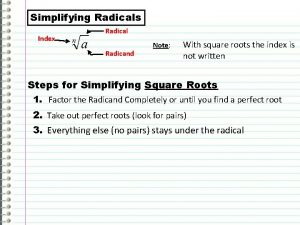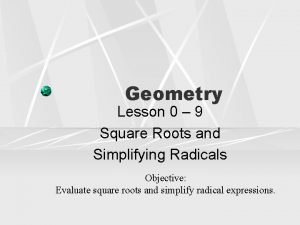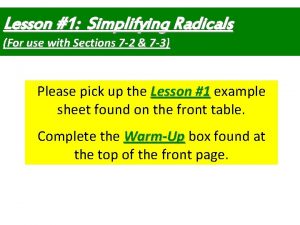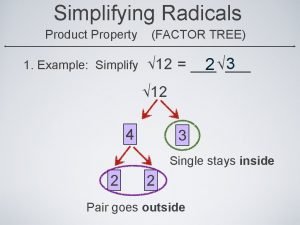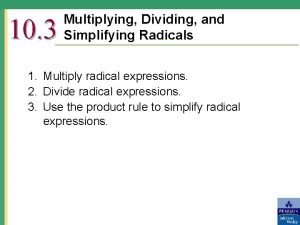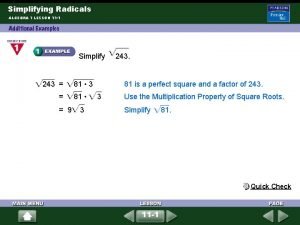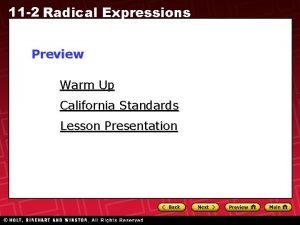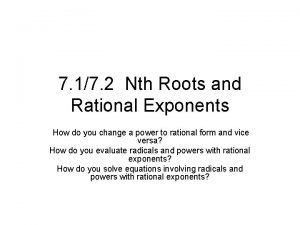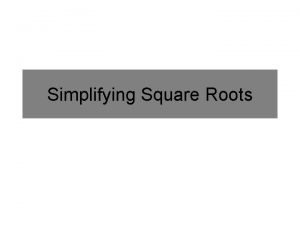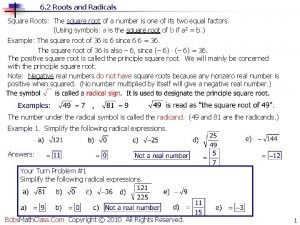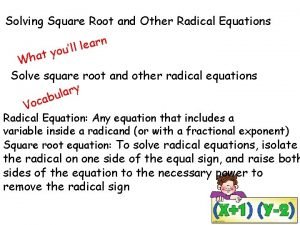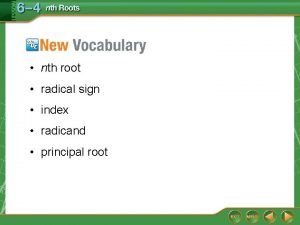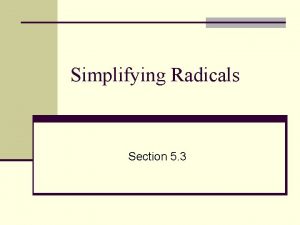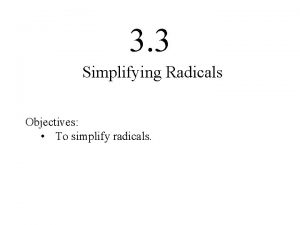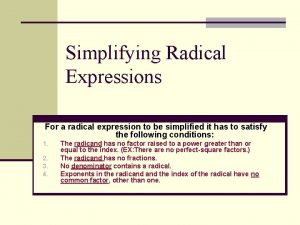Simplifying Radicals Index Radical Radicand Note With square

![Root Properties: [1] [2] If you have an even index, you cannot take roots Root Properties: [1] [2] If you have an even index, you cannot take roots](https://slidetodoc.com/presentation_image_h2/674e4d599f6daa7eecbf2c9ab37ac48b/image-2.jpg)
![General Notes: [1] [2] [3] 4 is the principal root – 4 is the General Notes: [1] [2] [3] 4 is the principal root – 4 is the](https://slidetodoc.com/presentation_image_h2/674e4d599f6daa7eecbf2c9ab37ac48b/image-3.jpg)
![Example 1 [A] [C] [B] [D] Example 1 [A] [C] [B] [D]](https://slidetodoc.com/presentation_image_h2/674e4d599f6daa7eecbf2c9ab37ac48b/image-4.jpg)
![Example 2: Simplify [B] [A] [C] [D] Example 2: Simplify [B] [A] [C] [D]](https://slidetodoc.com/presentation_image_h2/674e4d599f6daa7eecbf2c9ab37ac48b/image-5.jpg)
![Example 3: [A] [B] [C] [D] Example 3: [A] [B] [C] [D]](https://slidetodoc.com/presentation_image_h2/674e4d599f6daa7eecbf2c9ab37ac48b/image-6.jpg)
![Radicals CW Solutions [1] [2] [3] [4] [5] [6] [7] [8] [9] [10] [11] Radicals CW Solutions [1] [2] [3] [4] [5] [6] [7] [8] [9] [10] [11]](https://slidetodoc.com/presentation_image_h2/674e4d599f6daa7eecbf2c9ab37ac48b/image-7.jpg)

![Example 2 a] b] Example 2 a] b]](https://slidetodoc.com/presentation_image_h2/674e4d599f6daa7eecbf2c9ab37ac48b/image-9.jpg)
![Example 3 Finding Roots [A] [B] [C] [D] Example 3 Finding Roots [A] [B] [C] [D]](https://slidetodoc.com/presentation_image_h2/674e4d599f6daa7eecbf2c9ab37ac48b/image-10.jpg)
![Example 4 [A] Applications Using Roots The time T in seconds that it takes Example 4 [A] Applications Using Roots The time T in seconds that it takes](https://slidetodoc.com/presentation_image_h2/674e4d599f6daa7eecbf2c9ab37ac48b/image-11.jpg)
![Example 5 [B] Applications Using Roots The distance D in miles from an observer Example 5 [B] Applications Using Roots The distance D in miles from an observer](https://slidetodoc.com/presentation_image_h2/674e4d599f6daa7eecbf2c9ab37ac48b/image-12.jpg)

![Example 2 Foil a] b] c] d] Example 2 Foil a] b] c] d]](https://slidetodoc.com/presentation_image_h2/674e4d599f6daa7eecbf2c9ab37ac48b/image-14.jpg)

![Example 4 [A] [C] Adding / Subtracting Roots [B] [D] Example 4 [A] [C] Adding / Subtracting Roots [B] [D]](https://slidetodoc.com/presentation_image_h2/674e4d599f6daa7eecbf2c9ab37ac48b/image-16.jpg)












![Example 1 [A] Solving Radical Equations Algebraically [B] Example 1 [A] Solving Radical Equations Algebraically [B]](https://slidetodoc.com/presentation_image_h2/674e4d599f6daa7eecbf2c9ab37ac48b/image-29.jpg)
![Example 1 [C] [D] Example 1 [C] [D]](https://slidetodoc.com/presentation_image_h2/674e4d599f6daa7eecbf2c9ab37ac48b/image-30.jpg)



![Example 2 [A] Solving Graphically [B] x=½ Example 2 [A] Solving Graphically [B] x=½](https://slidetodoc.com/presentation_image_h2/674e4d599f6daa7eecbf2c9ab37ac48b/image-34.jpg)
![Example 2 Continued [C] [D] Y=4 x=3 Example 2 Continued [C] [D] Y=4 x=3](https://slidetodoc.com/presentation_image_h2/674e4d599f6daa7eecbf2c9ab37ac48b/image-35.jpg)
![Example 3 [A] No Solutions [B] x=Ø Example 3 [A] No Solutions [B] x=Ø](https://slidetodoc.com/presentation_image_h2/674e4d599f6daa7eecbf2c9ab37ac48b/image-36.jpg)
![Example 4 Misc. Equations [A] [B] x = -1, -2 x=3 Example 4 Misc. Equations [A] [B] x = -1, -2 x=3](https://slidetodoc.com/presentation_image_h2/674e4d599f6daa7eecbf2c9ab37ac48b/image-37.jpg)
- Slides: 37

Simplifying Radicals Index Radical Radicand Note: With square roots the index is not written Steps for Simplifying Square Roots 1. Factor the Radicand Completely or until you find a perfect root 2. Take out perfect roots (look for pairs) 3. Everything else (no pairs) stays under the radical
![Root Properties 1 2 If you have an even index you cannot take roots Root Properties: [1] [2] If you have an even index, you cannot take roots](https://slidetodoc.com/presentation_image_h2/674e4d599f6daa7eecbf2c9ab37ac48b/image-2.jpg)
Root Properties: [1] [2] If you have an even index, you cannot take roots of negative numbers. Roots will be positive. [3] If you have an odd index, you can take the roots of both positive and negative numbers. Roots may be both positive and negative
![General Notes 1 2 3 4 is the principal root 4 is the General Notes: [1] [2] [3] 4 is the principal root – 4 is the](https://slidetodoc.com/presentation_image_h2/674e4d599f6daa7eecbf2c9ab37ac48b/image-3.jpg)
General Notes: [1] [2] [3] 4 is the principal root – 4 is the secondary root (opposite of the principal root) ± 4 indicates both primary and secondary roots
![Example 1 A C B D Example 1 [A] [C] [B] [D]](https://slidetodoc.com/presentation_image_h2/674e4d599f6daa7eecbf2c9ab37ac48b/image-4.jpg)
Example 1 [A] [C] [B] [D]
![Example 2 Simplify B A C D Example 2: Simplify [B] [A] [C] [D]](https://slidetodoc.com/presentation_image_h2/674e4d599f6daa7eecbf2c9ab37ac48b/image-5.jpg)
Example 2: Simplify [B] [A] [C] [D]
![Example 3 A B C D Example 3: [A] [B] [C] [D]](https://slidetodoc.com/presentation_image_h2/674e4d599f6daa7eecbf2c9ab37ac48b/image-6.jpg)
Example 3: [A] [B] [C] [D]
![Radicals CW Solutions 1 2 3 4 5 6 7 8 9 10 11 Radicals CW Solutions [1] [2] [3] [4] [5] [6] [7] [8] [9] [10] [11]](https://slidetodoc.com/presentation_image_h2/674e4d599f6daa7eecbf2c9ab37ac48b/image-7.jpg)
Radicals CW Solutions [1] [2] [3] [4] [5] [6] [7] [8] [9] [10] [11] [12]

Radicals Simplifying Cube Roots (and beyond) 1. Factor the radicand completely 2. Take out perfect roots (triples) Example 1 a] b]
![Example 2 a b Example 2 a] b]](https://slidetodoc.com/presentation_image_h2/674e4d599f6daa7eecbf2c9ab37ac48b/image-9.jpg)
Example 2 a] b]
![Example 3 Finding Roots A B C D Example 3 Finding Roots [A] [B] [C] [D]](https://slidetodoc.com/presentation_image_h2/674e4d599f6daa7eecbf2c9ab37ac48b/image-10.jpg)
Example 3 Finding Roots [A] [B] [C] [D]
![Example 4 A Applications Using Roots The time T in seconds that it takes Example 4 [A] Applications Using Roots The time T in seconds that it takes](https://slidetodoc.com/presentation_image_h2/674e4d599f6daa7eecbf2c9ab37ac48b/image-11.jpg)
Example 4 [A] Applications Using Roots The time T in seconds that it takes a pendulum to make a complete swing back and forth is given by the formula below, where L is the length of the pendulum in feet and g is the acceleration due to gravity. Find T for a 1. 5 foot pendulum. Round to the nearest 100 th and g = 32 ft/sec 2.
![Example 5 B Applications Using Roots The distance D in miles from an observer Example 5 [B] Applications Using Roots The distance D in miles from an observer](https://slidetodoc.com/presentation_image_h2/674e4d599f6daa7eecbf2c9ab37ac48b/image-12.jpg)
Example 5 [B] Applications Using Roots The distance D in miles from an observer to the horizon over flat land or water can be estimated by the formula below, where h is the height in feet of observation. How far is the horizon for a person whose eyes are at 6 feet? Round to the nearest 100 th.

Simplifying Radicals 1. Multiply radicand by radicand 2. If it’s not underneath the radical then do not multiply, write together (ex: ) Example 1 Multiplying Radical Expressions [A] [B] [C] [D]
![Example 2 Foil a b c d Example 2 Foil a] b] c] d]](https://slidetodoc.com/presentation_image_h2/674e4d599f6daa7eecbf2c9ab37ac48b/image-14.jpg)
Example 2 Foil a] b] c] d]

Example 3 Simplify Sums / Differences • Find common radicand • Combine like terms a] b]
![Example 4 A C Adding Subtracting Roots B D Example 4 [A] [C] Adding / Subtracting Roots [B] [D]](https://slidetodoc.com/presentation_image_h2/674e4d599f6daa7eecbf2c9ab37ac48b/image-16.jpg)
Example 4 [A] [C] Adding / Subtracting Roots [B] [D]

SPECIAL FRACTION EXPONENT: The exponent is most often used in the power of monomials. Examples: Do you notice any other type of mathematical symbols that these special fraction exponents represent?

Special Fraction Exponents, , are more commonly known as radicals in which the N value represents the root or index of Index the radical. Radical Symbol Radicals: Radicand Note: The square root or ½ exponent is the most common radical and does not need to have the index written. Steps for Simplifying Square Roots 1. Prime Factorization: Factor the Radicand Completely 2. Write the base of all perfect squares (PAIRS) outside of the radical as product 3. Everything else (SINGLES) stays under the radical as a product.

Operations with Rational (Fraction) Exponents The same operations of when to multiply, add, subtract exponents apply with rational (fraction) exponents as did with integer (whole) exponents • Hint: Remember how to find common denominators and reduce. 1) 4) 2) 5) 3) 6)

Radicals CW Write in rational form. 1. 2. 3. 4. 7. 8. Write in radical form. 5. 6.

Radicals (Roots) and Rational Exponent Form Rational Exponents Property: OR OR Example 1: Change Rational to Radical Form A] Example 2: A] B] C] Change Radical to Rational Form B] C]

Radicals Classwork # 1 – 4: Write in rational form. 1. 2. 3. 4. 7. 8. #5 – 8: Write in radical form. 5. 6.

Radicals Classwork #2 Determine if each pair are equivalent statements or not. 1. 3. 5. and and 2. 4. 6. and and

Simplifying Rational Exponents • Apply normal operations with exponents. • Convert to radical form. • Simplify the radical expression based on the index and radicand. 1. 2. 3. 4. 5. 6. 7. 8.

Radicals Classwork #3 Simplify the following expressions into simplest radical form 1. 4. 2. 5. 3. 6.

Change of Base (Index or Root) • Write the radicand in prime factorization form • REDUCE the fractions of Rational Exponents to rewrite radicals. 1. 2. 3. 4. 3.

Change of Base Practice Problems 1. 4. 2. 5. 3. 6.

Radicals Radical Equation with a variable under the radical sign Extraneous Solutions Extra solutions that do not satisfy equation Radical Equation Steps [1] Isolate the radical term (if two, the more complex) [2] Square, Cube, Fourth, etc. Both Sides [3] Solve and check for extraneous solutions
![Example 1 A Solving Radical Equations Algebraically B Example 1 [A] Solving Radical Equations Algebraically [B]](https://slidetodoc.com/presentation_image_h2/674e4d599f6daa7eecbf2c9ab37ac48b/image-29.jpg)
Example 1 [A] Solving Radical Equations Algebraically [B]
![Example 1 C D Example 1 [C] [D]](https://slidetodoc.com/presentation_image_h2/674e4d599f6daa7eecbf2c9ab37ac48b/image-30.jpg)
Example 1 [C] [D]

Radicals CW Solve Algebraically. 9. 10. 11. 12.

Radicals CW Solve Algebraically. 13. 14.

Radicals CW Solve Algebraically. 15. 16. No Solution x=4
![Example 2 A Solving Graphically B x½ Example 2 [A] Solving Graphically [B] x=½](https://slidetodoc.com/presentation_image_h2/674e4d599f6daa7eecbf2c9ab37ac48b/image-34.jpg)
Example 2 [A] Solving Graphically [B] x=½
![Example 2 Continued C D Y4 x3 Example 2 Continued [C] [D] Y=4 x=3](https://slidetodoc.com/presentation_image_h2/674e4d599f6daa7eecbf2c9ab37ac48b/image-35.jpg)
Example 2 Continued [C] [D] Y=4 x=3
![Example 3 A No Solutions B xØ Example 3 [A] No Solutions [B] x=Ø](https://slidetodoc.com/presentation_image_h2/674e4d599f6daa7eecbf2c9ab37ac48b/image-36.jpg)
Example 3 [A] No Solutions [B] x=Ø
![Example 4 Misc Equations A B x 1 2 x3 Example 4 Misc. Equations [A] [B] x = -1, -2 x=3](https://slidetodoc.com/presentation_image_h2/674e4d599f6daa7eecbf2c9ab37ac48b/image-37.jpg)
Example 4 Misc. Equations [A] [B] x = -1, -2 x=3
 Index of a radical
Index of a radical Lesson 0-9 square roots and simplifying radicals answers
Lesson 0-9 square roots and simplifying radicals answers Differentiate like radicals from unlike radicals
Differentiate like radicals from unlike radicals Unit 11 radicals homework 5 dividing radicals day 1
Unit 11 radicals homework 5 dividing radicals day 1 18 1/4 in simplest radical form
18 1/4 in simplest radical form Simplifying radicals with factor tree
Simplifying radicals with factor tree Radical worksheet
Radical worksheet Simplifying radicals multiplication
Simplifying radicals multiplication Combine these radicals -6√100+√36
Combine these radicals -6√100+√36 Unit 7-1 simplifying radicals answer key
Unit 7-1 simplifying radicals answer key Dmca square root
Dmca square root Simplifying radicals worksheet doc
Simplifying radicals worksheet doc Simplify square root of 252
Simplify square root of 252 Simplifying radical quiz
Simplifying radical quiz 11-2 simplifying radical expressions answers
11-2 simplifying radical expressions answers Simplifying radicals jeopardy
Simplifying radicals jeopardy 11-2 simplifying radical expressions
11-2 simplifying radical expressions Simplify radicals worksheet algebra 1
Simplify radicals worksheet algebra 1 Radical expressions with fractions
Radical expressions with fractions Simplify radical expression
Simplify radical expression Rational exponent to radical form calculator
Rational exponent to radical form calculator Quadratic formula example
Quadratic formula example Radicand parts
Radicand parts Square root of 72 in radical form
Square root of 72 in radical form Entire radical
Entire radical Radical terminology
Radical terminology Unit 6 radical functions homework 4 rational exponents
Unit 6 radical functions homework 4 rational exponents Linear method of note taking
Linear method of note taking Goods received note
Goods received note Difference between note making and note taking
Difference between note making and note taking Simple discount
Simple discount Signal words for cause and effect
Signal words for cause and effect What is debit note
What is debit note Difference between note making and note taking
Difference between note making and note taking What is credit note and debit note
What is credit note and debit note Rational exponent notation
Rational exponent notation Square root of 72 in radical form
Square root of 72 in radical form Root of equation
Root of equation
